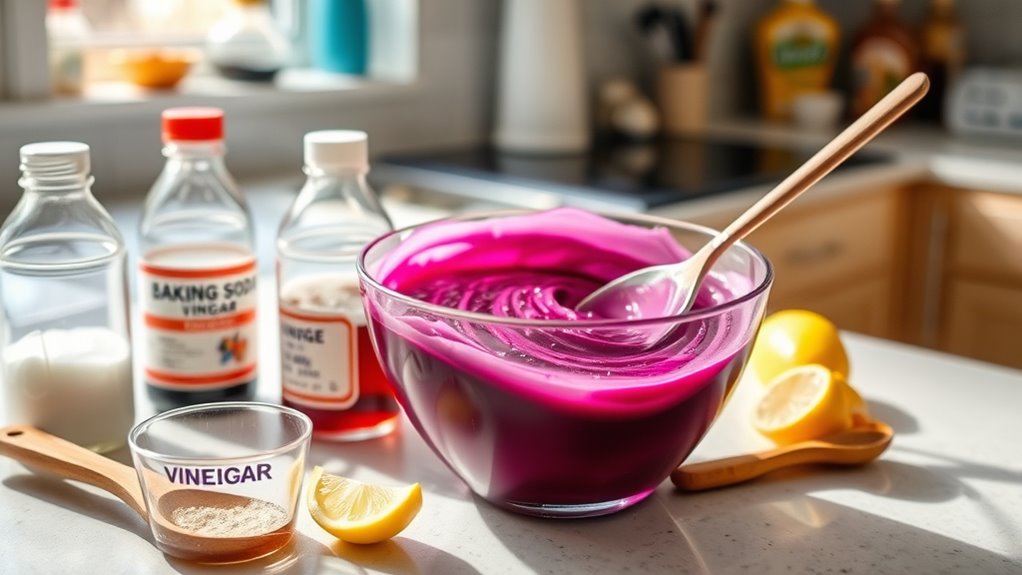You can explore safe, simple kitchen science experiments using pantry items like vinegar, baking soda, lemon juice, and sugar. For example, combine vinegar and baking soda to produce a fizzy reaction, or heat sugar to make caramel. You can also create homemade slime with cornstarch and water or experiment with pH levels using lemon juice and milk. These easy activities reveal fascinating chemical changes and boost your understanding of cooking using everyday ingredients. Keep exploring to uncover more fun and educational ideas.
Key Takeaways
- Use common pantry ingredients like vinegar, baking soda, lemon juice, and sugar for safe, simple experiments.
- Conduct reactions such as fizzing with baking soda and vinegar or making caramel to demonstrate chemical changes.
- Create edible gel spheres through spherification techniques using household supplies like sodium alginate and calcium chloride.
- Observe caramelization by heating sugar to see color and flavor changes safely on the stovetop.
- Experiment with pH by adding lemon juice or baking soda to foods to observe effects on texture and appearance.

Have you ever wondered how everyday kitchen ingredients can reveal fascinating scientific phenomena? When you start exploring the science behind cooking, you access a world where chemistry and creativity collide. Molecular gastronomy, a branch of food science, uses scientific principles to transform ordinary ingredients into extraordinary textures and flavors. By understanding the chemical reactions involved, you can turn your kitchen into a science lab, creating edible miracles with simple pantry items. This approach isn’t just about cooking; it’s about exploring how molecules behave and interact under different conditions, giving you a deeper appreciation of the food on your plate.
For example, when you combine vinegar and baking soda, you initiate a chemical reaction that produces carbon dioxide gas. It’s a classic experiment that’s both fun and educational, illustrating how acids and bases react to form new substances. The bubbling fizz demonstrates the release of gas, and you can see firsthand how chemical reactions produce observable changes. This same principle underpins many cooking processes, like fermentation or leavening bread. Understanding these reactions helps you control and manipulate textures and flavors, making your culinary creations more precise and innovative.
Vinegar and baking soda produce carbon dioxide gas, illustrating chemical reactions that enhance cooking and baking techniques.
Molecular gastronomy often involves techniques that manipulate ingredients at a molecular level to create surprising textures or appearances. Think of spherification, where liquids are turned into gel-like spheres that resemble caviar. This process relies on the interaction of sodium alginate and calcium chloride, which creates a thin gel membrane around the liquid. It’s a perfect example of applying chemical reactions to produce new culinary experiences. You don’t need fancy equipment—just pantry staples—and a willingness to experiment. These techniques show how understanding chemical reactions allows you to push the boundaries of traditional cooking.
Many simple kitchen experiments demonstrate how chemical reactions influence flavor, texture, and appearance. For instance, heating sugar causes caramelization, transforming its color and flavor through complex chemical changes. Similarly, adding lemon juice to milk causes it to curdle, a process driven by acid-base reactions that produce curds and whey. These reactions aren’t just culinary tricks—they’re fundamental scientific principles that you can observe and manipulate at home. Exploring them helps demystify the science behind cooking and encourages you to experiment confidently. Additionally, understanding the role of temperature and pH in these reactions can help you improve your culinary techniques and develop new recipes.
Frequently Asked Questions
Can Kids Perform These Experiments Alone Safely?
Kids can perform these experiments safely if you provide proper supervision and emphasize safety precautions. Always stay nearby to guide them and prevent mishaps. Make sure they understand how to handle ingredients carefully, avoid ingestion, and use utensils properly. By supervising closely and explaining safety rules upfront, you help kids enjoy learning without risking accidents, making the experiments both fun and safe.
Are There Any Allergies Linked to Common Pantry Items Used?
Food allergies are like hidden landmines, so you should always stay alert. Common pantry items like nuts, eggs, or dairy can trigger food allergies, so it is crucial to check labels and know allergy awareness. If you or your kids have known allergies, avoid using those ingredients in experiments. Always supervise and consult with a healthcare professional if you’re unsure about potential allergy risks, ensuring safe and fun kitchen science adventures.
How Can I Modify Experiments for Older Children?
You can modify experiments for older children by increasing complexity with age-appropriate modifications, like adding measurements or exploring chemical reactions. Guarantee safety precautions are emphasized, such as wearing goggles or gloves when necessary. Encourage critical thinking by asking questions about the science behind each step, and allow them to experiment more independently, fostering curiosity while maintaining safety and understanding of potential hazards.
What Are Some Science Projects Using Only Natural Ingredients?
Think of natural ingredients as your science playground. You can create colorful volcanoes using baking soda and lemon juice, or make homemade slime with honey and cornstarch. These projects are safe experimentation, perfect for exploring chemical reactions without harmful chemicals. You might also try growing crystals from salt or sugar solutions. With natural ingredients, you turn everyday pantry items into exciting science adventures, fostering curiosity and learning safely at home.
Can These Experiments Be Done Outdoors or in a Classroom?
Yes, you can do these experiments outdoors or in a classroom. Just guarantee outdoor safety by choosing a flat, clean area away from distractions, and supervise children closely. For classroom setup, organize materials beforehand and create a designated space for each experiment. Both settings work well, but always prioritize safety, keep the workspace tidy, and be ready to adapt activities based on your environment.
Conclusion
Think of your kitchen as a tiny universe where everyday ingredients become stars of discovery. Just as explorers chart unknown worlds, you can navigate the cosmos of science with simple pantry items. Each experiment is a voyage, revealing secrets hidden in familiar surroundings. So, keep your curiosity fueled and your senses sharp—your kitchen is a launchpad for endless adventures. Embrace the role of scientist and explorer, turning mundane into marvelous with every turn of the spoon.









